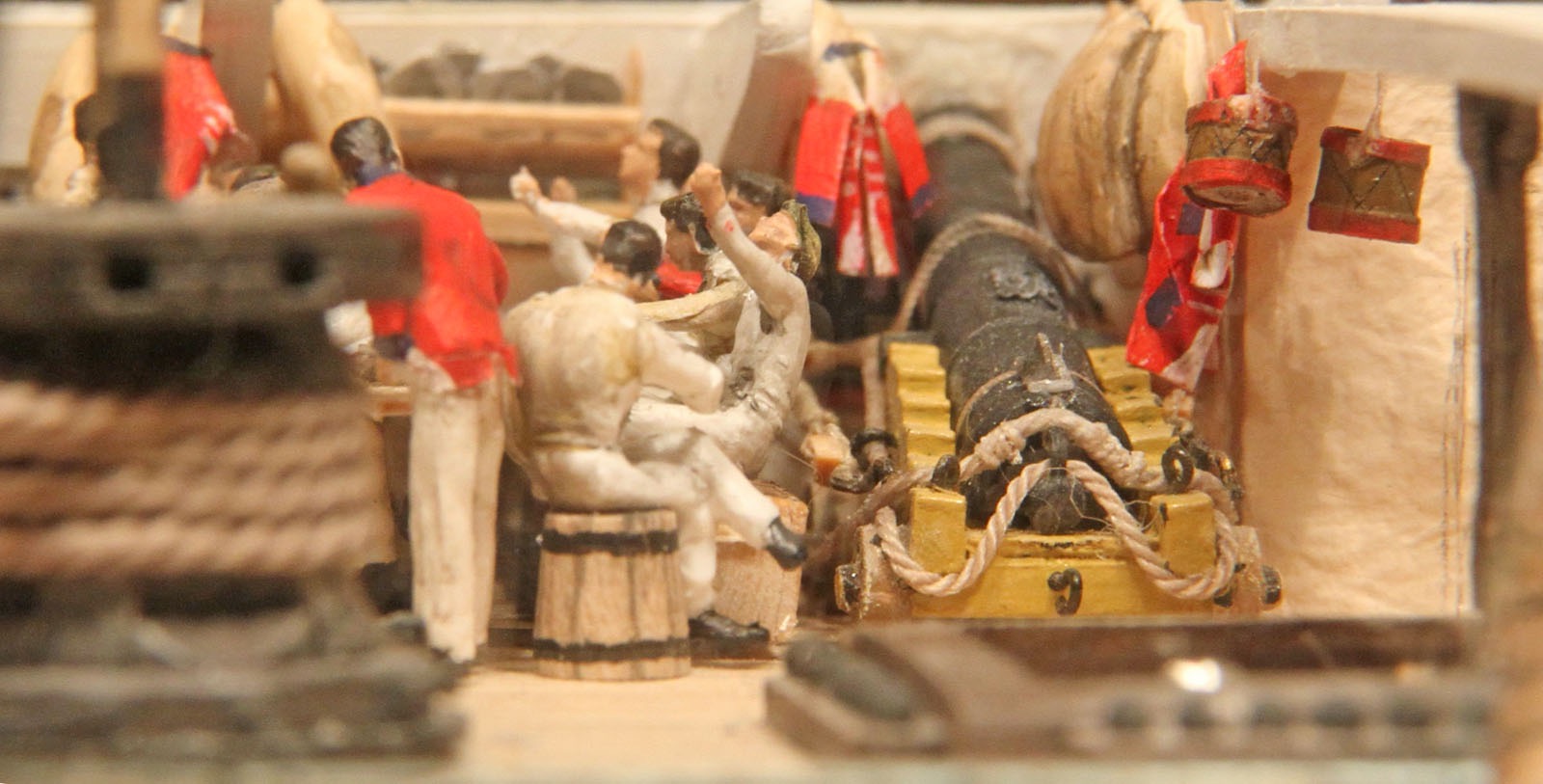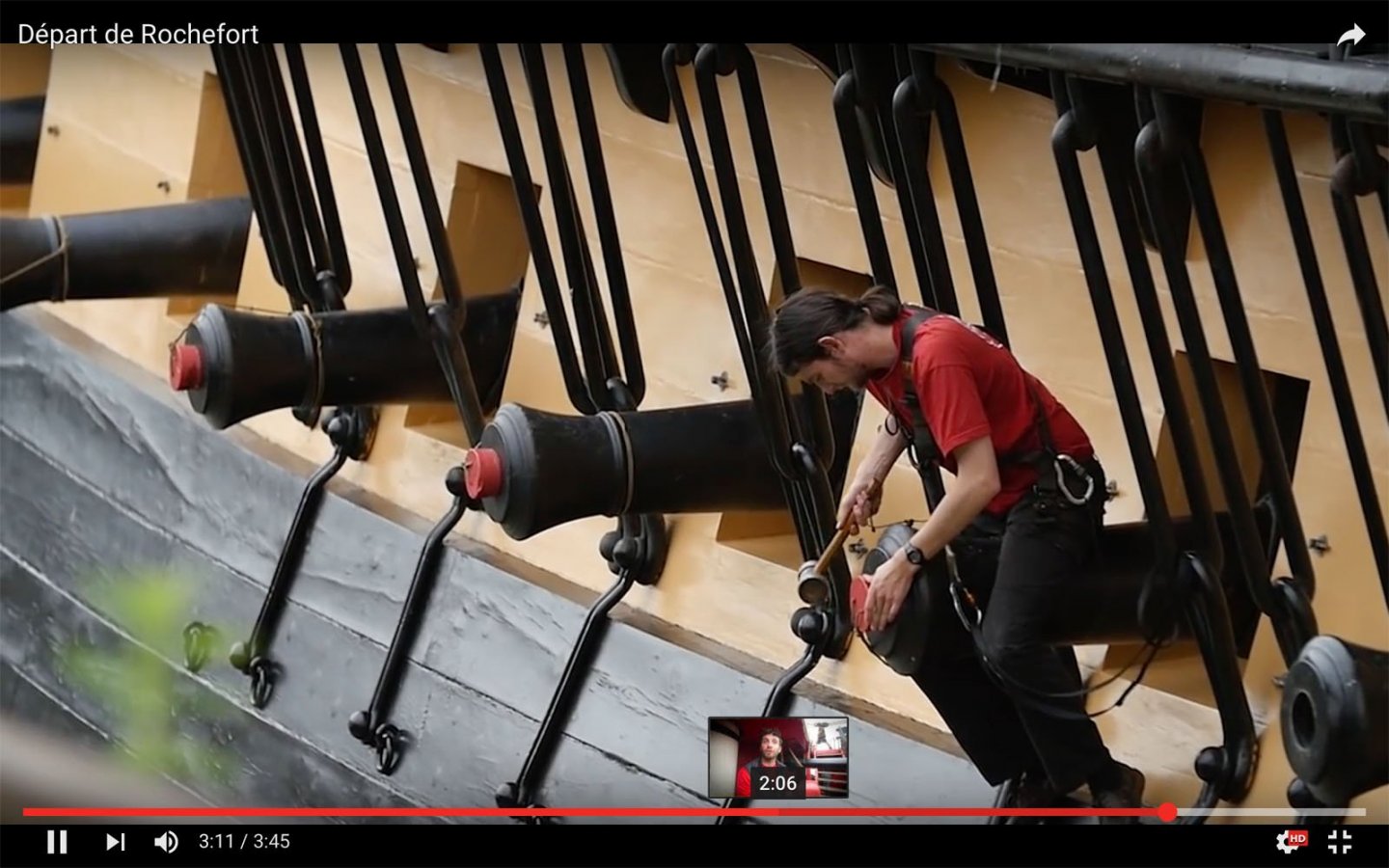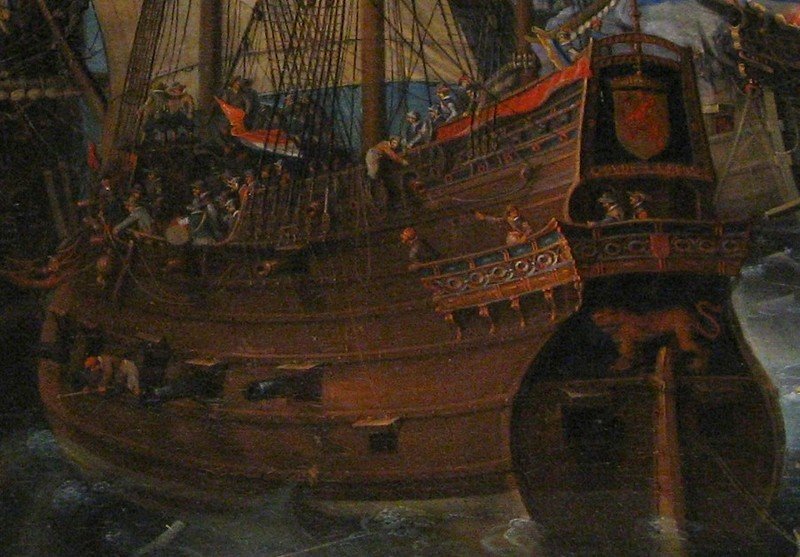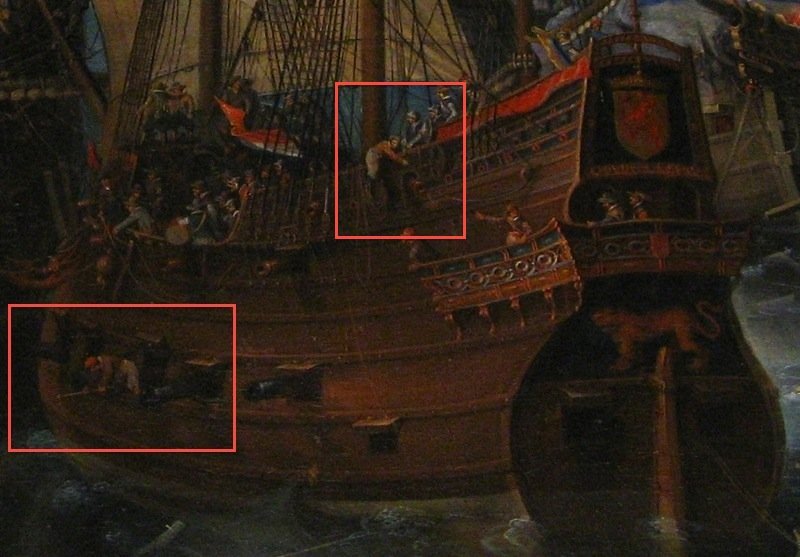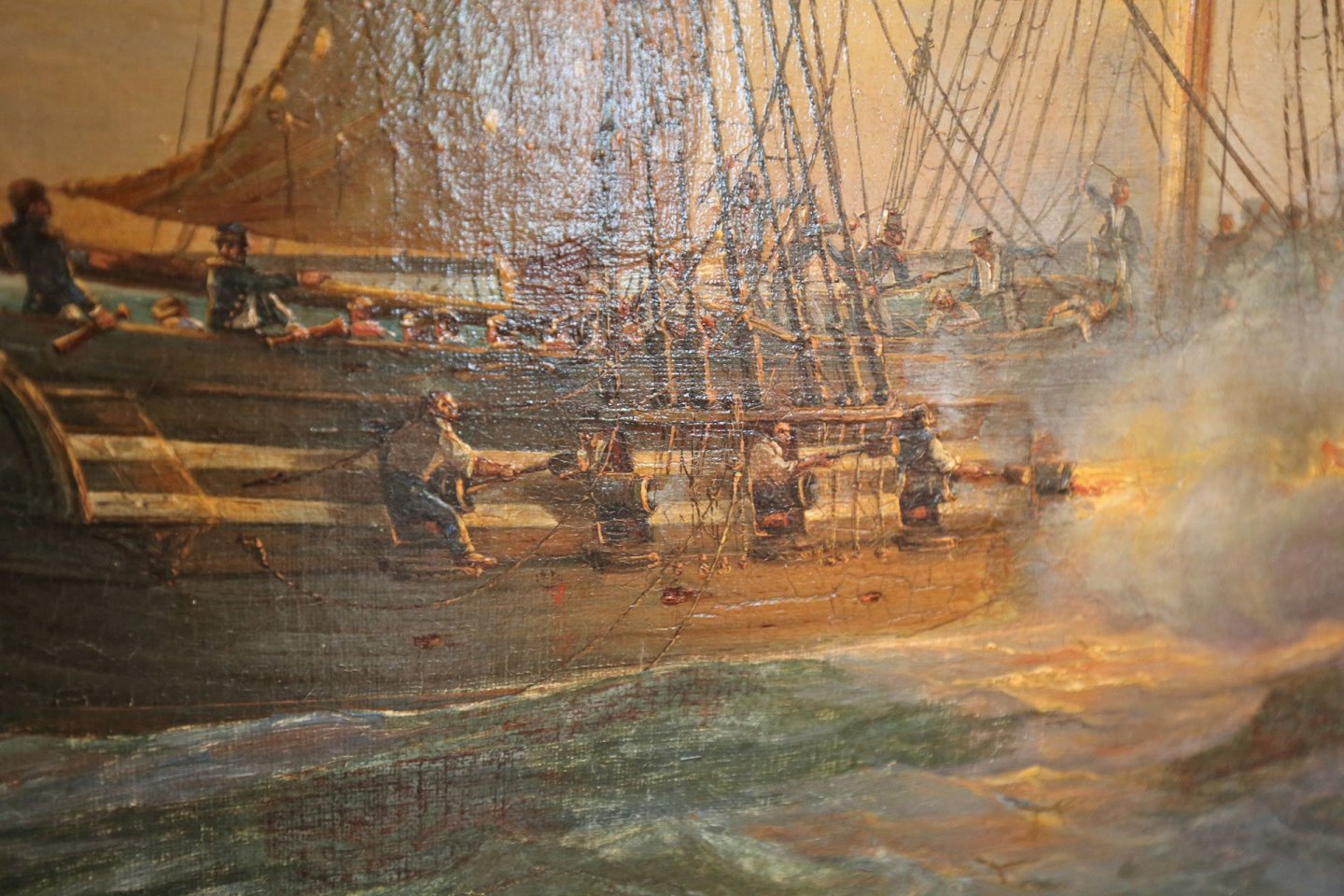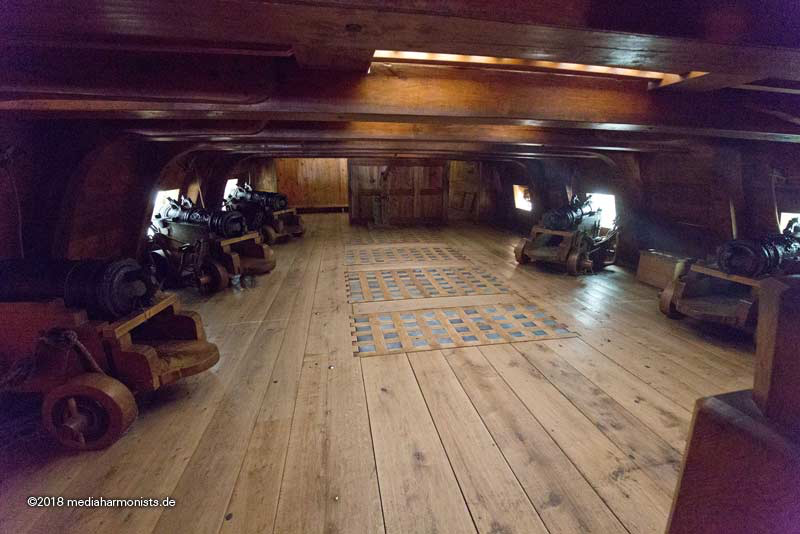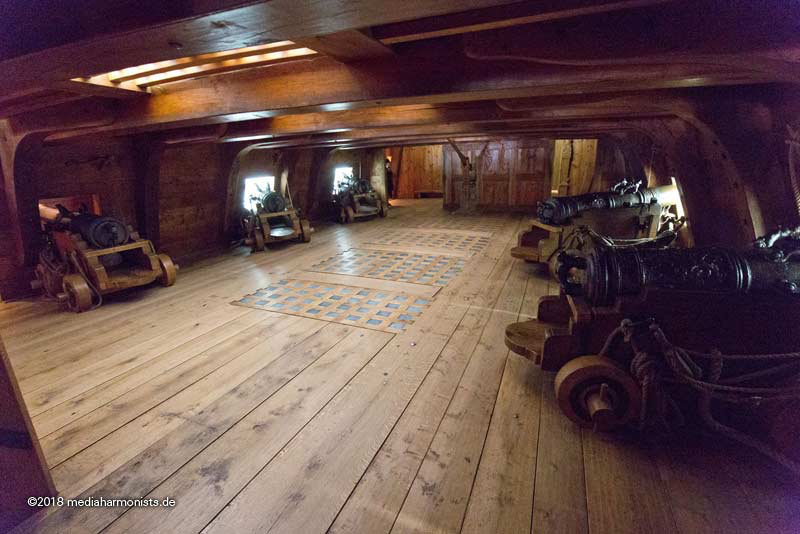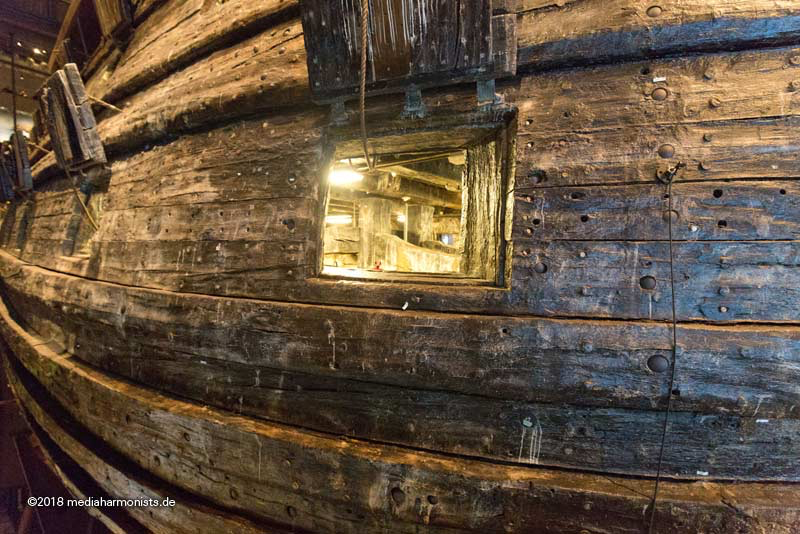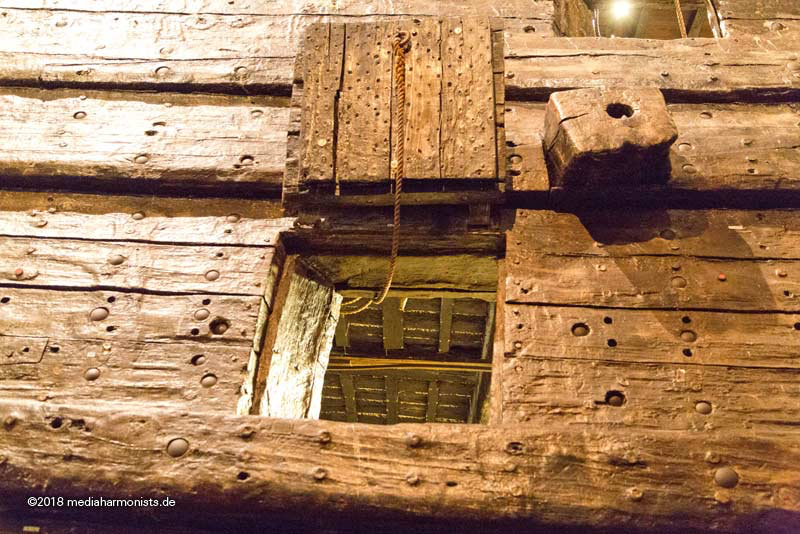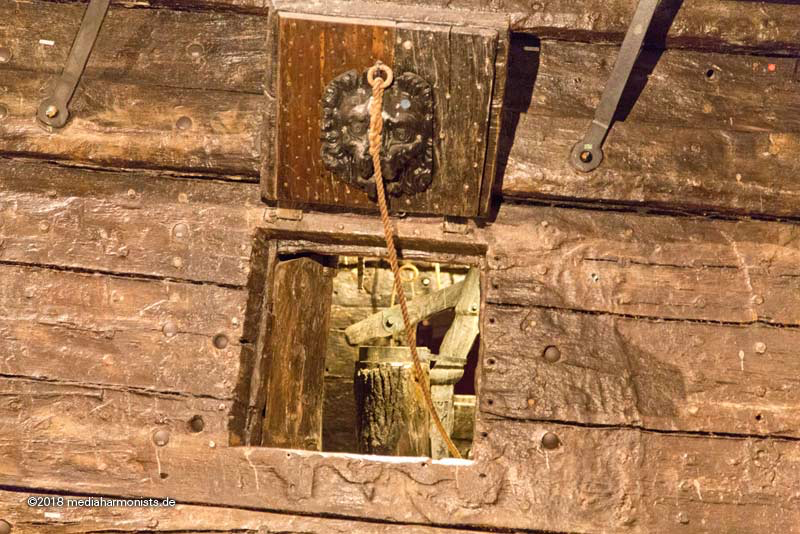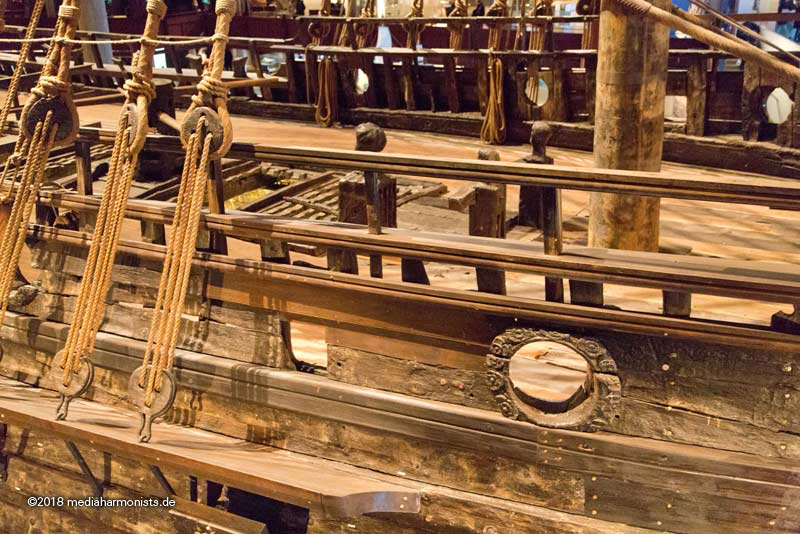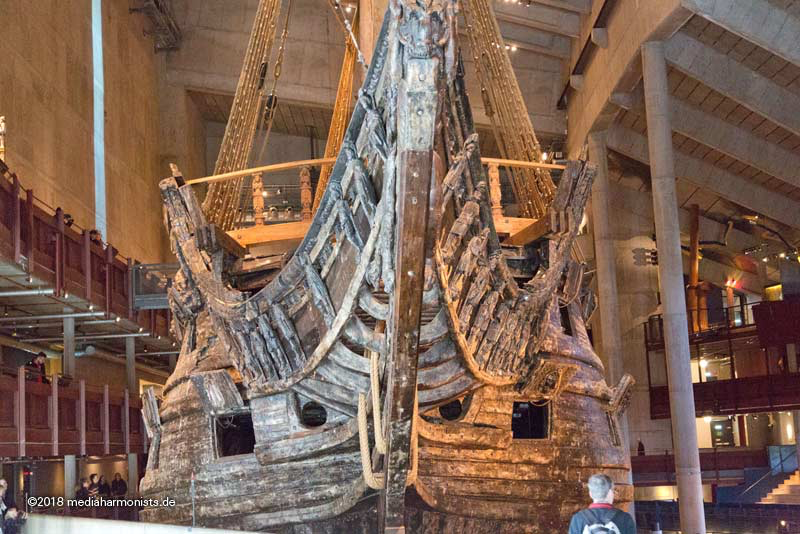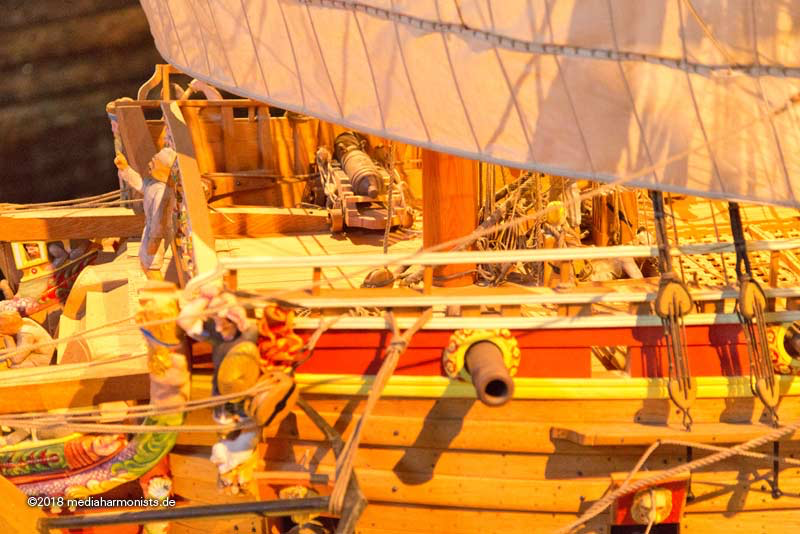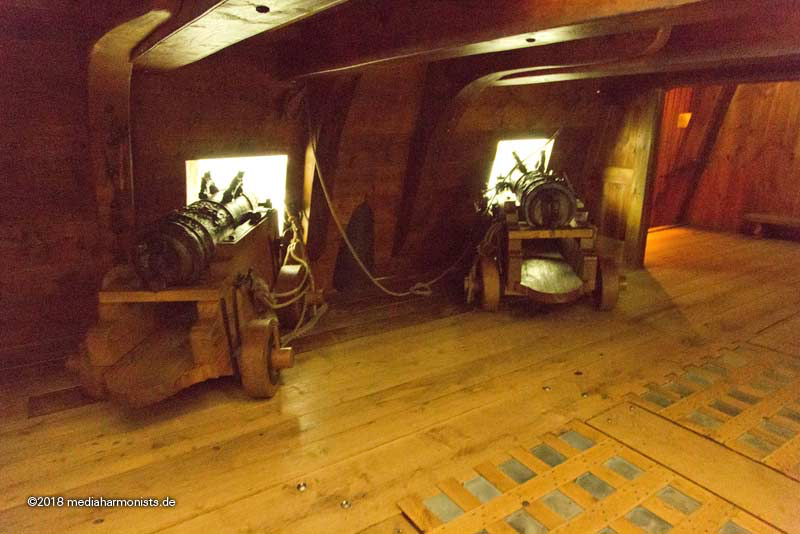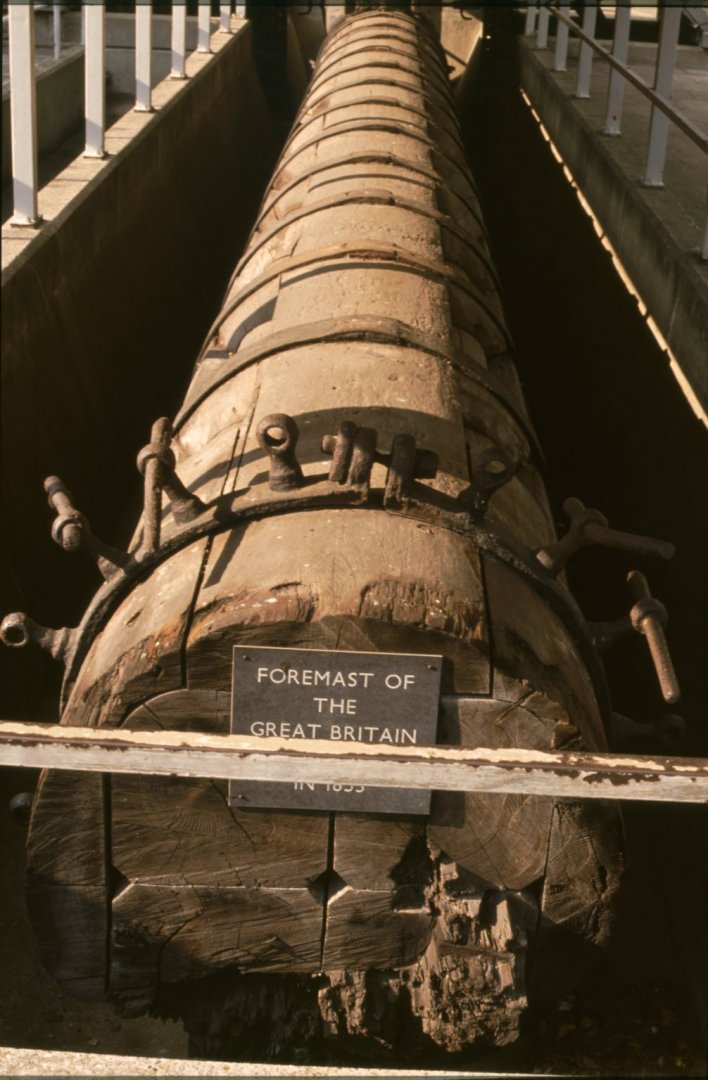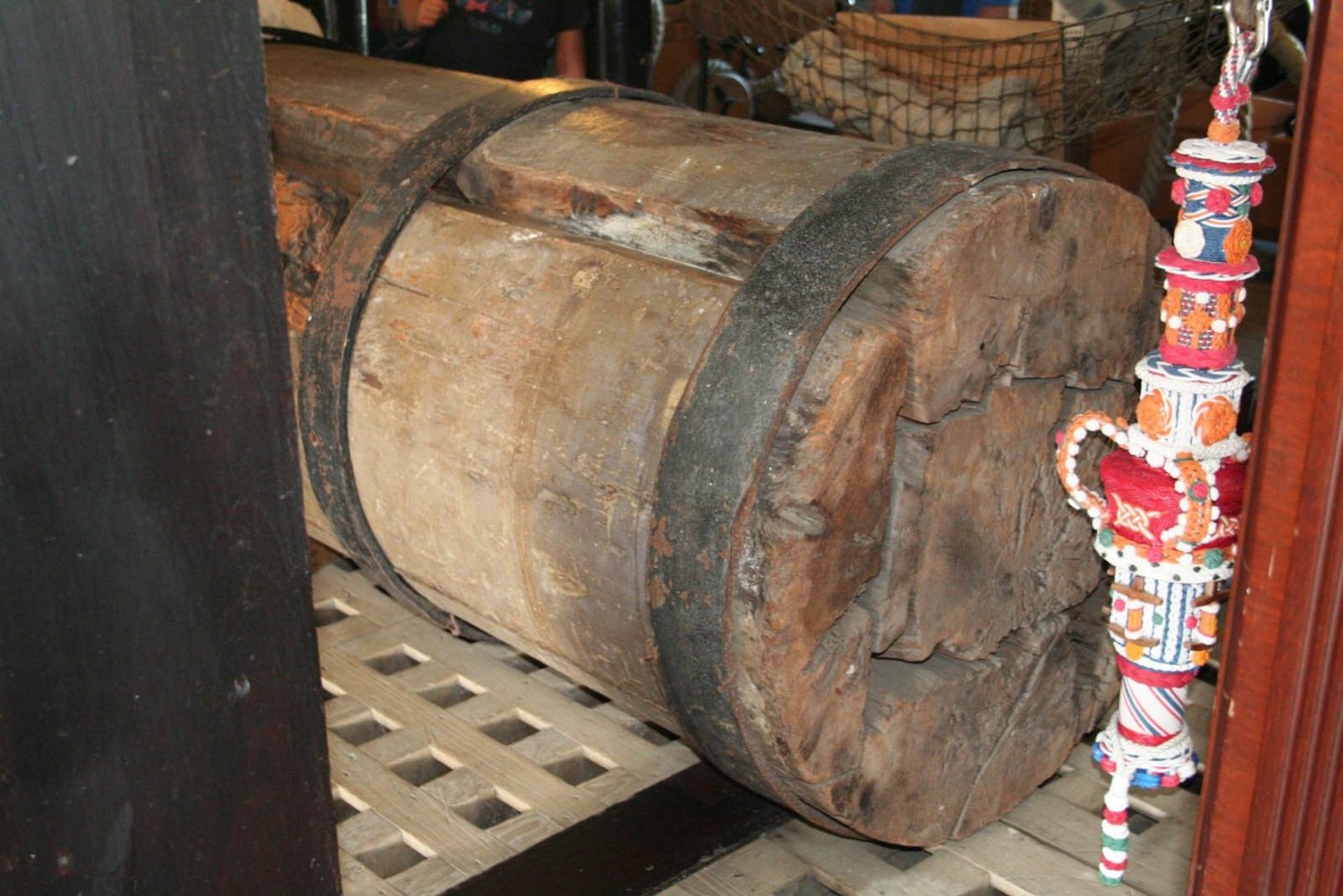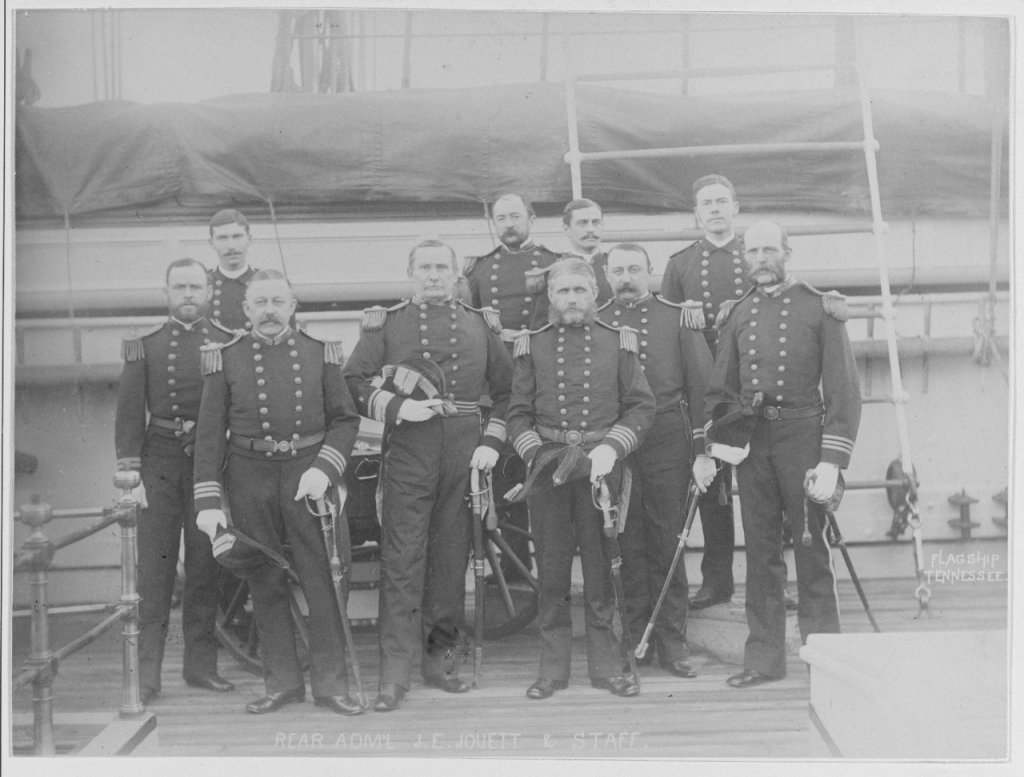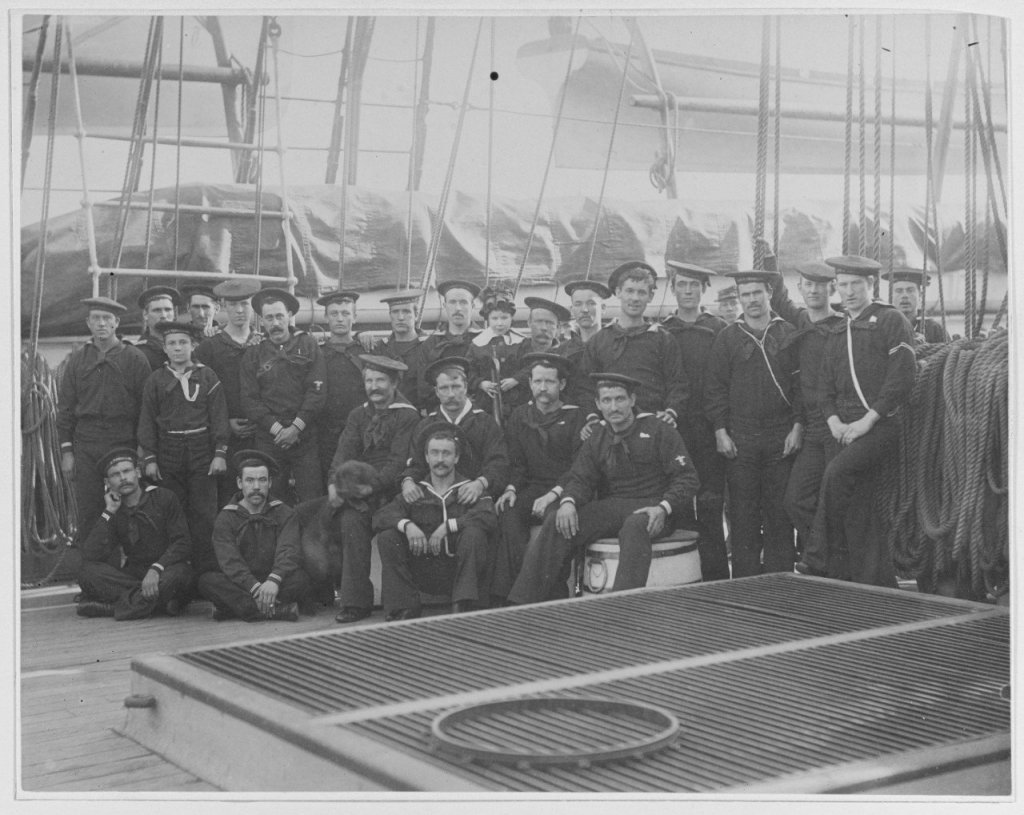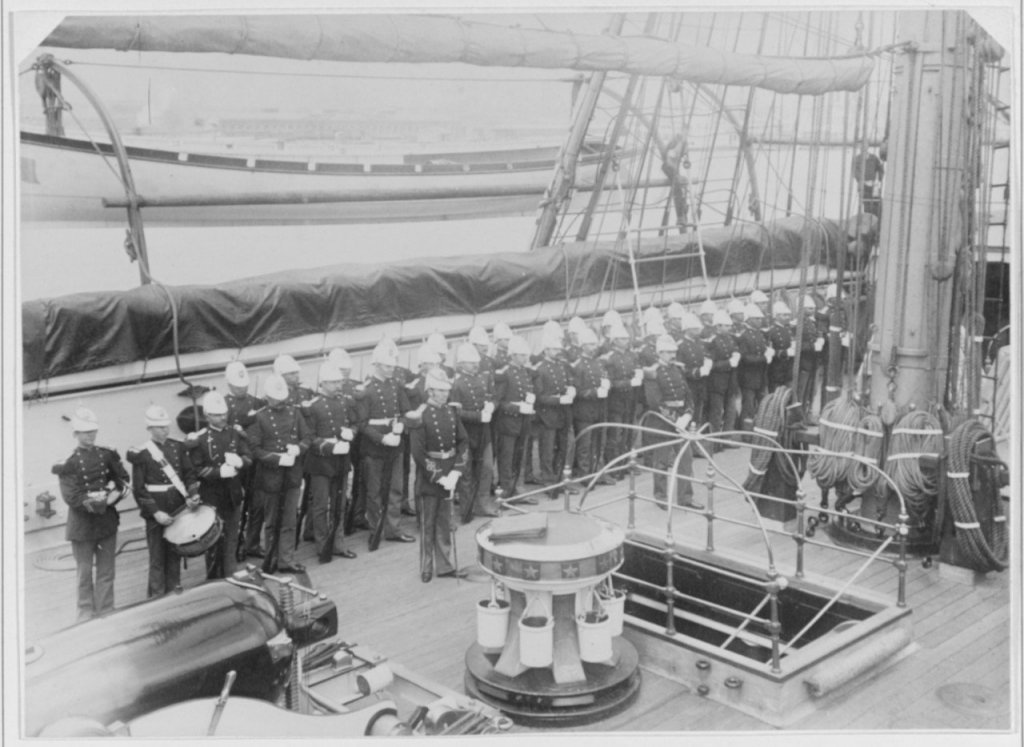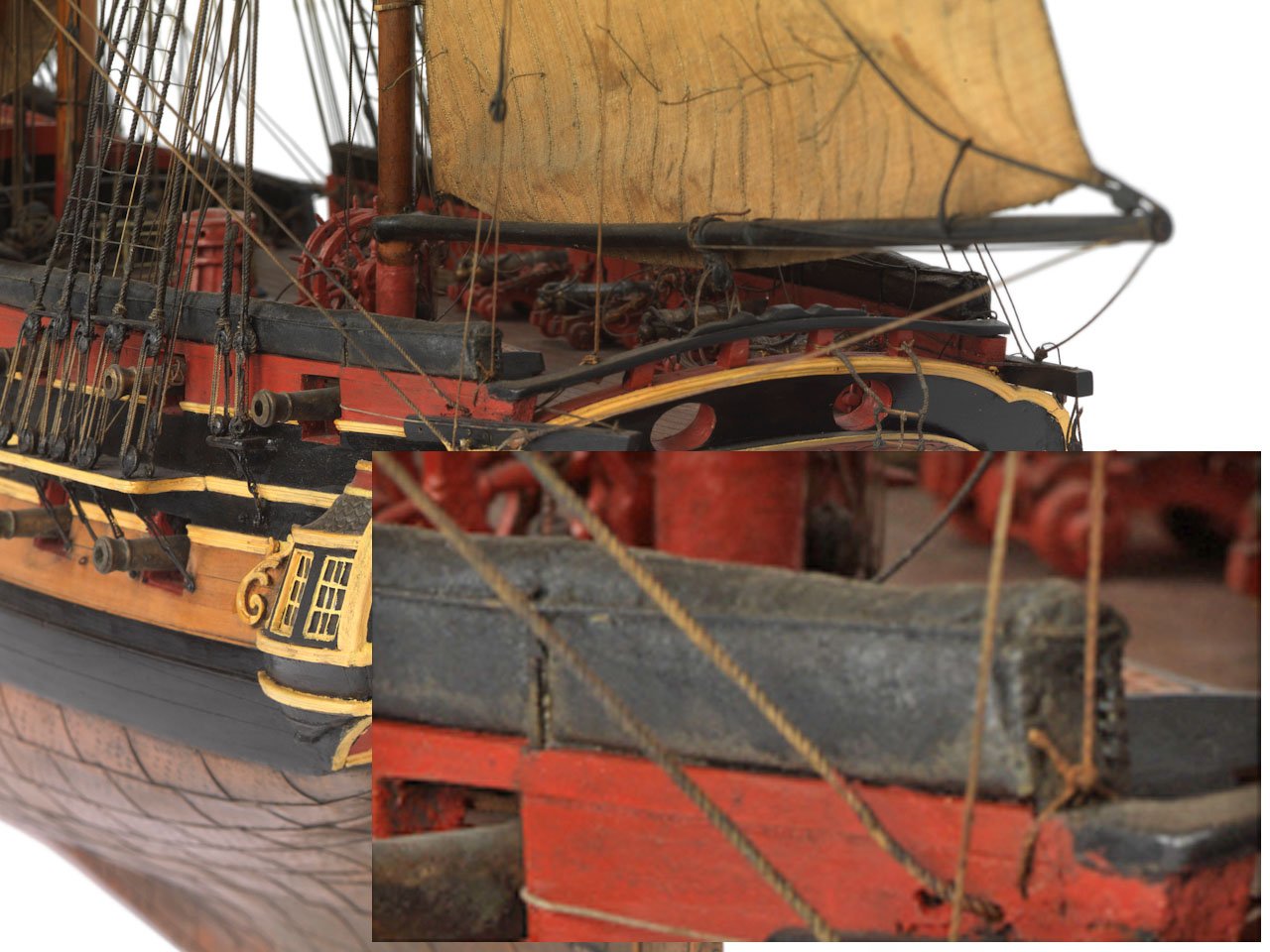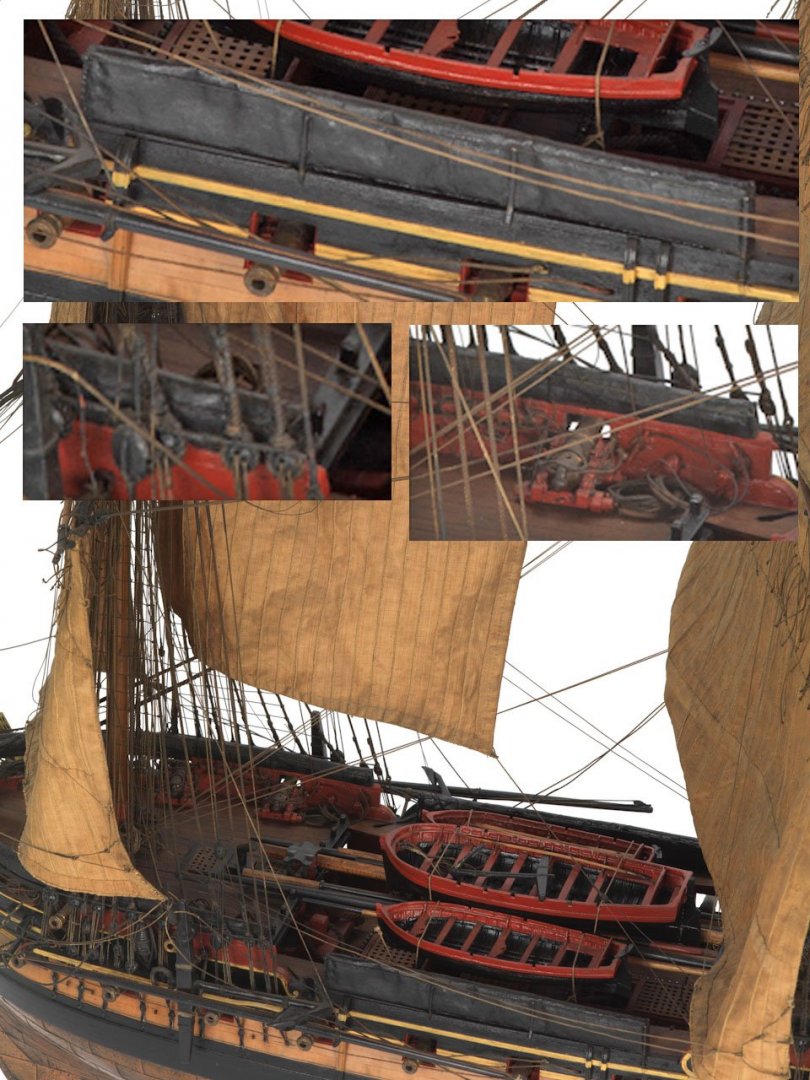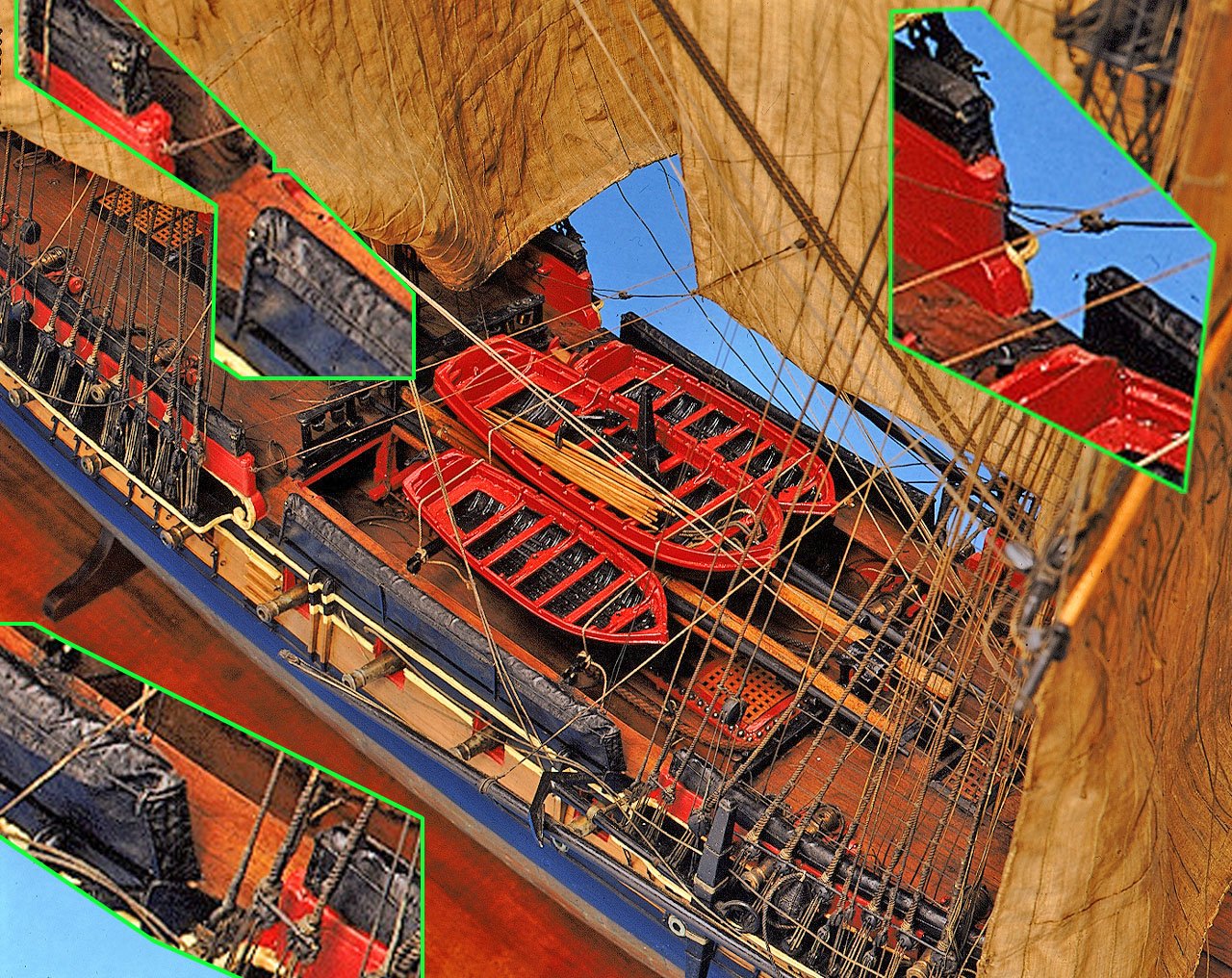-
Posts
2,426 -
Joined
-
Last visited
Content Type
Profiles
Forums
Gallery
Events
Everything posted by dafi
-
And sitting on the gun is not unusual to be seen on paintings. Also later on to be seen with the french ... And a fresh picture of Hermione, giving a hint what it would mean 😉
-
Not a really early ship, but still to be seen in the Vasa. The two first guns on each deck only can fire forward seen the angle of the port, the two rearmost guns each deck only aftwards. Also the big gun on the forecastle points very much forward, as its port shows. This also can be seen, as this gun is colliding with the cathead as result of the 90° position in the 1:10 reconstruction 😉
-
So the trilogy of the 4 slices is almost done 🙂 - 1765 to 1780 (as build) - September 1805 mid Atlantic on the chase of Villeneuve - 1920 before docking - and the latest revamp 2018 Still have to make a nice frame. XXXDAn
-
Luckily @Morgan discovered a small detail in the large Turner painting: The anchor lining, almost hidden by the fallen fore sail. Looking at the Turner scribbles there is a line, that could be interpreted as the bolster for the lost lining. Looking at the Queen Charlotte of the the same time, one could see how it should have looked. First the frame was added ... ... then I realised that the lower batten should have been the bolster. Took one step that was left from the entry port and it fitted 🙂 Unfortunately it broke while fixing 😞 The replacement part was bent the wrong way, so I took the time for a cup of tea and did hang the part inside to make it flexible, bent it the right direction and let it cool down in its new shape. After fixing it, I realised that it sat not properly ... ... even the paint did not help. So another disassembly took place ... ... and then it fitted 🙂 As the anchor lining was to protect the hull and the irons from the anchor, I wanted to show some scratches. First I took a spare anchor to simulate its way up ... But how do those scratches look like? It was not a metal hull with clean rounded scratches, but I opted for some splinters on the edges of the planks and some flakes of paint coming off. The color I oppted for a warm siversih grey, like old exposed wood is showing. Need some black ink to simulate depth. After the lanyards was fixed ... ... things were done 🙂 Cheers, DAniel
-
It is possible, that the quarter Davits were not present at Trafalgar, as they are missing on the Turner drawings and all post-Trafagar drawings too and are shown for the first time on a drawing of 1822 if I recall well. The stern davits were already disassembled several years ago. All the best, DAniel
-
-
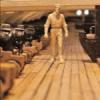
Hammock crane cover
dafi replied to dafi's topic in Discussion for a Ship's Deck Furniture, Guns, boats and other Fittings
The bolt rope is a good hint. My personal guess would have been single pieces from stanchion to stanchion with a decent overlap, tied down with an eye or loop like you wrote. If the sides are longer on the outside with overlap on the deck (gangway) or bulwark (q´deck), then the water should not come in but easily get out, and if the inside is just a bit shorter to allow water to go out (gangway) and to air properly. Sounds at least reasonable and a good working guess. Thank you, DAniel -
Thats why I like to call it an "Almost-Replica". And I do not mean it bad. The did a good job imho to keep this wonderful heritage alive, regarding the money and the existing knowledge about the times. And this knowledge was expanded a lot within the last years, thank god. XXXDAn
-
Thank you rkwz Nice still from the film, one can see nicely both colors and how messy the wood is 🙂 From Victory in her true Colours: https://www.youtube.com/watch?v=KmNXRWtQ-P0 XXXDAn
-
Hello Gary, thank you! That is a very good base for reconstruction. And thank you for the hint I missed the lining completely! Have still to fix it. All the best, DAniel
-

Hammock crane cover
dafi replied to dafi's topic in Discussion for a Ship's Deck Furniture, Guns, boats and other Fittings
Gary thank you!!! Lesson learned, look back to the sources you worked already on 🙂 Need to double check the other Turner drawings for the details he emphasizes ... -
Thank you Sirs! O Goody, I missed the 215th anniversary that happend 4 days ago of that little depicted scene. Logentry on the 08/08/1805, somewhere in between Gibraltar and Spithead "08.08.1805 painted quarter deck and hull" 🙂 🙂 🙂 And that was only 16 days before the ship underwent a short refit at Spithead. Within 7 days she got the guns removed, the spars sent down for check, the sails checked, and plenty of caulking was done. Afterwards she went to sea immediately but the delivery of a larger quantity of paint suggests, that the painting went on on sea. Recorded is the 10/09/1805 that the Breadroom was whitewashed. But still good to know, that exactly today, 215 years ago on the 08/12/1805, the main topgallant sail split in a squall. XXXDAn
-
After missing information on how the covers were fixed, I opted for easy folds and will change that as suitable information comes. Still got some netting on the face side and fixed an iron hook. After a transatlantic voyage, I suppose the ship to look a bit tattered. So some man are meant to do do a small face lift 🙂 So the last slice is done. Still need to clean the others up and fix them on the frame. Soon this project is finally to be finished 🙂 Titel: 1805 mid Atlantic, return from the Caribbean, ... Enjoy, DAn
-
One question I have is about the hammock crane covers. Sources say it was sail cloth either painted or tarred. Very nice detail for smaller scales to omit the nettimg 😉 Interesting also for larger scales - like my 1:100 ( 😉 ) to apply some extra detail. But the question is, how was it fixed? Was it simply thrown over and fixed on the cranes i a way to be open from underneath? Was it in multiple parts like a bag with a separate flap or cover on top? Was it also covering the cranes or was it inside with the cranes visible? Are there any contemporary sources giving clues for that? Here is one of the few models of the days of the hammock cranes with cover. Still the question ist, if this is original or was it added in the said restoration? https://collections.rmg.co.uk/collections/objects/66307.html SLR0346 Scale 1:48. A contemporary full hull model of a frigate (circa 1805) built plank on frame in the Georgian style. Model is decked, equipped, and fully rigged with a full suit of sails set. The hull is complete with copper sheathing which was added in the 1960s by Jim Lees in the Museum's workshop.This contemporary model is fully rigged together with sails, which are thought to be original. The hull has the solid bulwarks on the upper decks and an enclosed waist, both of which offered greater protection to the crew when under fire. It is has a full complement of boats from the large launch to the smaller jolly boat mounted on davits hanging over the stern. The copper sheathing below the waterline was introduced by the Navy in the 1780s. Its purpose was two-fold: it prevented weed growth, which would reduce the ship’s speed, and to stop damage to the timbers by the marine boring toredo worm. Date made circa 1805 Here some details: In the last pictured one could guess that there is a flap on the outside of the gangwax hammock cover, just onderneath the rope. Here some pictures of later days, when the cranes were replaced by boxes. XXXDAn
-
Back to the slices 🙂 Luckily found some old spare decks to cut a small stripe for the visible Gangway. Then "tarred" the hammock netting, this time a bit darker than I usually do. Used some paper stripes for easy assembly ... ... shortened the inboard side ... ... and fixed it. Then fixed the net on the rope on the outboard side, always giving a touch of gravity into the ropes. Made the hammocks with Magic Sculpt. Dry test ... ... and the colored with all the colors of life ... ... and put in place Still thinking how the cover should be fixed in a contemporary fashion ... XXXDAn
-
@Morgan Yes and I thank you for pointing the lining out to me. But are there references how this looked as the chain board was set up one deck higher at Trafalgar? XXXDAn
-
It is a very interesting model with many features rarely seen: All the scuppers on the decks Open Top of the side galleries Side gallery windows with different rhythm of battens D-Blocks for mizzen and main mast different colors of the inside of the ports! number of eyebolts on the port lids Lid of the quarterdeck ports have the lanyards up to the poop Axiometer Gratings Qurterdeck Skylight with flat top All the different colors of the inside hull Eyebolts beside the Preventer Chains for tightening the shrouds form of the side entry steps Scuttles for Top Tackles straight chimney Preveter chains for the rudder, leading to the poop (!) And many more features 🙂 🙂 🙂 The only thing I do not understand are the stantions for the hammock netting on the quarter deck. This does not make too much sense to my understanding. Any idea about that? XXXDAn
-
Thank you druxey, Thomas and Brian No those were kind people, not intending mischief to others, and only having the furnace for repairing the gun! The french were the ones using the red hot shots like Admiral Collingwood wrote on page in his diary 31/32 about Glorious First of June: "TO J. E. BLACKETT, ESQ. Barfleur, at Sea, June 5, 1794. ... Four of their ships were provided with furnaces for redhot shot, one of which stuck in the Royal Sovereign, but I have not heard that they did any mischief in any part of the fleet by them. " https://books.google.de/books?id=vS4yAQA...epage&q&f=false Also there are still a lot of build in stone furnaces in many french fortresses, one in a tower from Brest among. 😉 XXXDAn
-
Heave! (Quist:) Five years hard labor, the judge says to me... ...or honorable service in His Majesty's Navy. What did I pick? Hornblower. ... (Sailor:) What are we doing in the Pacific, anyway? I tell you, he's got us all lost. ... (Quist:) There's islands there where we could have a picnic. Brown-skinned girls, bread growing on trees, where the Bounty went. Why don't you ask Hornblower to take us there? What's wrong with our cargo doing the asking? Muskets and ammunition. Who for? Why not for us? Harrison: Come on, get on with your work. Get on with it. Those were the last words in March 2015. Last year the conversation was continued in the moment when another model fell onto the small setup: AUUUUUUUTSCH!!! All men over board, the freshly fitted furnace in pieces. Never found the time for repair. Yesterday while looking for something else the remains were found again and also the will to fix 🙂 First found that Quist took the chance to desert and run behind his brown-skinned girls. So cloned a new one using the original building report from March 2015. Also fixed the furnace and lighted the ember inside. Also a new feature appeared: The wetted sand underneath the furnace, I finally found sand or better saying powder of sand that suited fine enough for the job. Also the waterbucket found its way onto the scene. Just missing the fire engine, the hose or the wet swatters that were needed to follow fire regulations. Then checked for the right tools. Tinkered the tongs from a spare chain iron ... ... and also an anvil found itself being used in there. And here we go with the refreshed gem 🙂 And here it is with the inspiration, from the starting sequence of "Hornblower" about 3:00 min. Enjoy, DAn
-
Actually not much more 🙂 In my one there is everything my heart desires. But actually and anyway, the time consuming part is not the build, it is the research ... XXXDAn
-
Thank you for the feedback! Managed to get all the eyelets onto their leashes ... ... and threaded them in ... ... and all closed ports are done 🙂 XXXDAn
-
Here we go again. First cleaning the front edge of the channel board from paint and leveling the heights of the irons ... ... and then fixing the batten to hold the deadeyes in place. From near one can see the difference nicely. One more area finished. Then the gunport lanyards. Still had some sprue, that was hollowed and pulled over the candle, resulting in nice micro tubes 🙂 Those bits were made from leather, to protect against friction and to keep water out. Took a needle to reopen the holes after cutting and used the intended thread to check the inner diameter. The spliced the ring onto the lanyard and hooked the ring onto the lid. Checked from near and I think it could be considered to be ok. So five or six more lids to go ... Grüßle, Daniel
About us
Modelshipworld - Advancing Ship Modeling through Research
SSL Secured
Your security is important for us so this Website is SSL-Secured
NRG Mailing Address
Nautical Research Guild
237 South Lincoln Street
Westmont IL, 60559-1917
Model Ship World ® and the MSW logo are Registered Trademarks, and belong to the Nautical Research Guild (United States Patent and Trademark Office: No. 6,929,264 & No. 6,929,274, registered Dec. 20, 2022)
Helpful Links
About the NRG
If you enjoy building ship models that are historically accurate as well as beautiful, then The Nautical Research Guild (NRG) is just right for you.
The Guild is a non-profit educational organization whose mission is to “Advance Ship Modeling Through Research”. We provide support to our members in their efforts to raise the quality of their model ships.
The Nautical Research Guild has published our world-renowned quarterly magazine, The Nautical Research Journal, since 1955. The pages of the Journal are full of articles by accomplished ship modelers who show you how they create those exquisite details on their models, and by maritime historians who show you the correct details to build. The Journal is available in both print and digital editions. Go to the NRG web site (www.thenrg.org) to download a complimentary digital copy of the Journal. The NRG also publishes plan sets, books and compilations of back issues of the Journal and the former Ships in Scale and Model Ship Builder magazines.

